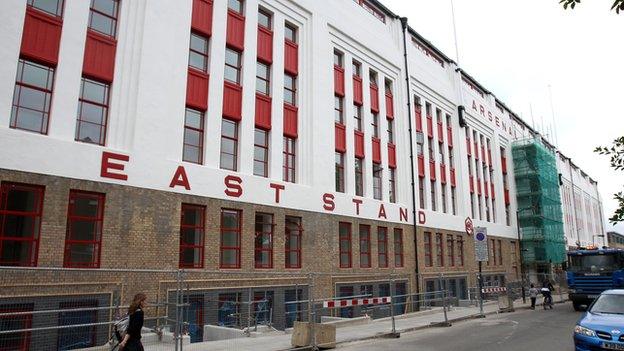Was football better before the Premier League?
- Published

Steve Nicol (right) of Liverpool comes in to tackle Norman Whiteside of Manchester United in a 1-1 draw at Old Trafford in October 1985
The dawn of the Premier League in 1992 changed football forever: big-money TV deals, new stadiums and more foreign players. But was football better in the days of muddy pitches, heaving terraces and cheaper tickets? BBC News has been speaking to fans, ex-players and academics.

Footballers in the pop charts
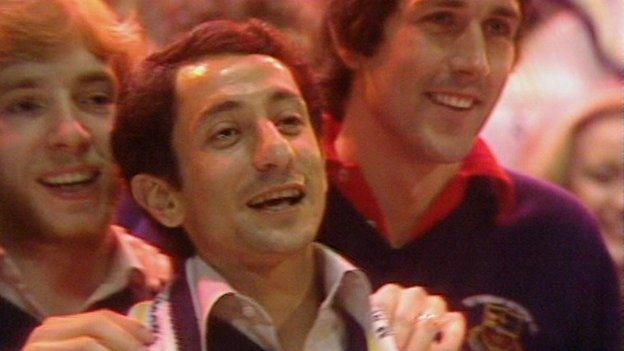
Ossie Ardiles sang "in the cup for Tottingham" as he and his teammates reached number five in the charts
There was a time when a bunch of footballers could beat the likes of Madness, Human League and Tom Jones in the charts.
England's 1970 World Cup squad paved the way with number one hit Back Home, and in 1981 FA Cup winners Tottenham - with help from Chas and Dave - reached number five with Ossie's Dream (Spurs Are On Their Way to Wembley).
Martin Cloake, 49, of Tottenham Hotspur Supporters' Trust, remembers their appearance on Top of the Pops.
"If you look now, it's a real classic: perms, (players) in V-neck jumpers from Marks and Sparks swaying around with woolly scarves… and old Chas and Dave on the piano," he said.
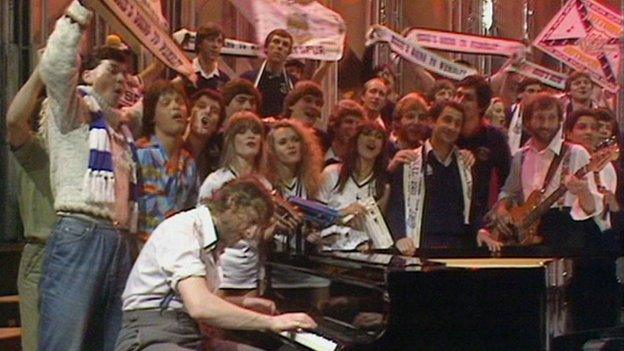
Fan Martin Cloake said Ossie's Dream quickly became a terrace favourite
"The audience (were) probably looking slightly confused as it wasn't exactly Hot Chocolate."
Tottenham's assault on the charts did not end there. In 1987 Glenn Hoddle and Chris Waddle gave us Diamond Lights, a number 12 hit. Hoddle was England manager less than a decade later.

Players living round the corner
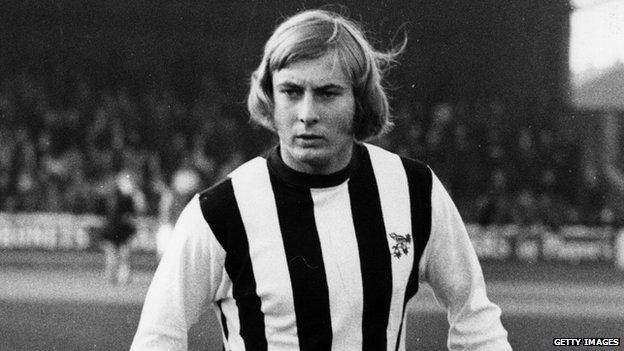
Asa Hartford scored for West Bromwich Albion as they beat Manchester United in 1968
Before big Premier League pay packets, players were more likely to live down your road and drink in your local pub.
In April 1968 FA Cup finalists West Bromwich Albion took on championship-chasing Manchester United, who were also heading for the European Cup final, in the league at The Hawthorns, winning 6-3.
Albion supporters' club chairman John Homer, 59, said: "Can you imagine the hype around that game if it was today? It would be phenomenal.
"(Goalscorer) Asa Hartford at the end of the game caught the 74 (bus) back to West Bromwich, had a fish and chip supper and then went home to his digs. I find that absolutely wonderful."
Mr Homer said most players lived locally, playing darts and crib in local pubs.
"Jeff Astle lived in the heart of West Bromwich and used to go in the same paper shop as a lot of supporters," he said.
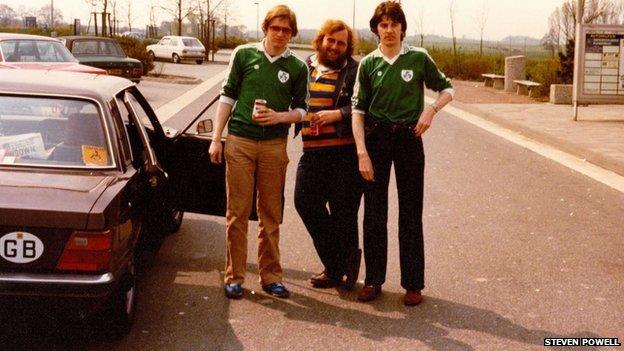
Steven Powell (centre) with brothers Joe (left) and Maurice Mulcahy, travelling back from Arsenal's 1-0 win at Juventus in the European Cup-Winners' Cup semi-final second leg in 1980
Arsenal fan Steven Powell, 58, from Islington, met Gunners star Ray Kennedy at Fulham Broadway tube station after a match against Chelsea, during the 1970/71 league and FA Cup double-winning season.
Kennedy was travelling back to the north east by train to visit his sick mother.
Mr Powell said: "You couldn't see the current generation of stars standing on a tube station with the fans after a London derby.
"They're more likely to have a privately-chartered helicopter to see their mum if she was ill."

Cup final magic under the Twin Towers
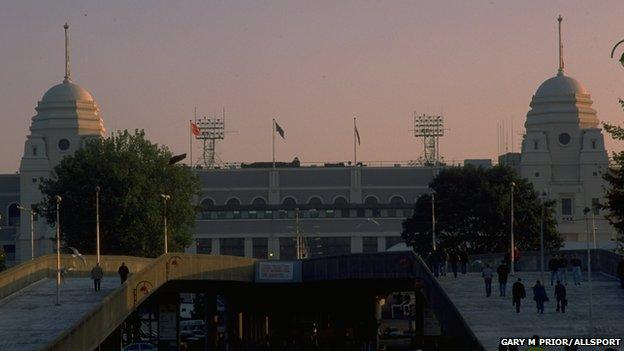
The original Wembley Stadium, built in 1923, hosted five European Cup finals, the 1948 Olympic Games and the Live Aid concert in 1985
FA Cup finals are still played at Wembley, but many features of the old stadium - the 39 steps climbed by the teams, the Royal Box in the north stand and the Twin Towers - were lost when it was redeveloped.
Second Division Sunderland caused one of the biggest-ever FA Cup final shocks there, beating Leeds United 1-0 in 1973.
Jimmy Montgomery, their goalkeeping hero that day, said the new Wembley was "absolutely fantastic" but added: "I just wish they'd incorporated the Twin Towers into the new stadium."
A famous image from the 1973 final is Sunderland manager Bob Stokoe, in his hat, coat and red tracksuit bottoms, racing over to celebrate with Montgomery.
"My wife still cries her eyes out (seeing that on TV)," said Montgomery, now 71.
With the victorious squad travelling on to a league fixture, their wives were left to take the trophy back to Sunderland.
"They had the cup on the card table on the coach," said Montgomery.
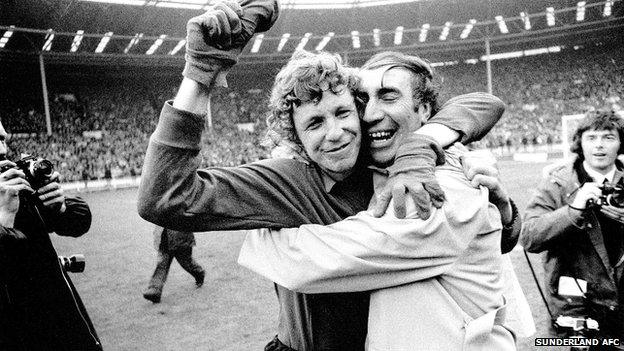
Sunderland manager Bob Stokoe (right) celebrated with goalkeeper Jimmy Montgomery after the game
"They stopped off at Wetherby... and they took the cup into the service station."
He finds it difficult to compare football then and now, but backs one old routine.
"(Now there are) fitness gurus; dieticians. I look back and I had fillet steak pre-match. It never did us any harm."

Watching the game on Ceefax
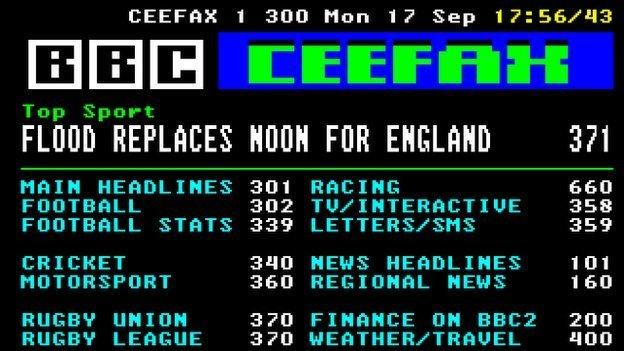
Ceefax listed latest scores and provided match reports
When live TV matches were still a rarity, people would follow a game on teletext services Ceefax and Oracle.
Scores would disappear from the screen every few seconds as the page cycled through the matches in alphabetical order.
Watford fan Stuart Clarke, 53, of football culture website Homes of Football, external, said: "It was clunky to use, going between the divisions keeping track of more than one team.
"I don't know about magical - it was an interesting way of getting scores... My dad thought it was the greatest thing going."
Other ways to stay informed included buying a Saturday sports paper or watching the results on BBC's Grandstand or ITV's World of Sport.
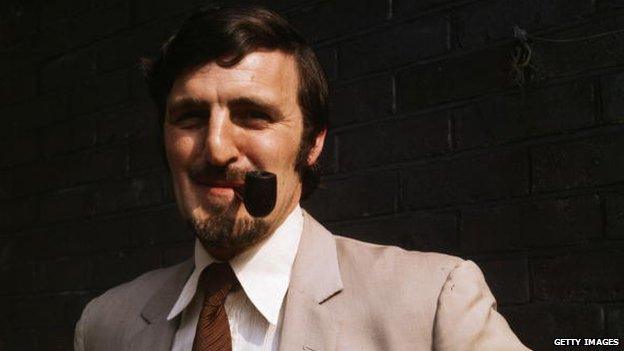
Jimmy Hill, pictured in 1970, presented Match of the Day on the BBC and The Big Match on ITV
World Cups were transmitted in more primitive colour with commentators on crackly phone lines.
FA Cup finals were rare live TV matches. Cameras followed players on their team buses, or even helicopter, in the case of Brighton in 1983.
Match of the Day featured highlights from just three matches per show.
Nick Owen, ITV's main sports presenter from 1986 to 1992, said: "When you'd gone to interview a manager, sometimes they just couldn't be bothered to do it in the end so you'd hang about for hours in draughty corridors... They looked down on us as lesser beings."
Now a BBC Midlands Today presenter and Luton Town chairman, he remembers one editing mistake in which a white ball was cleared by a goalkeeper but viewers saw a brown one landing near the centre circle.

Only one substitute - and outfield players in goal
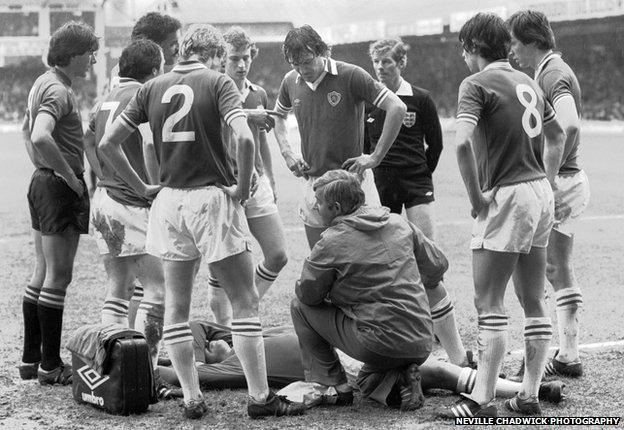
Leicester striker Alan Young (next to the referee) and winger Steve Lynex (number 7) went in goal after goalkeeper Mark Wallington got injured - Gary Lineker is wearing the number 8 shirt
In the days before squad numbers, shirts were numbered from one to 11 and had no player or sponsors' names on them.
With just one substitute per team, if a goalkeeper got injured, an outfield player would replace him.
In March 1982 Leicester beat Shrewsbury 5-2 in a dramatic FA Cup quarter-final, despite changing goalkeeper three times.
They were 2-1 down at Filbert Street when Mark Wallington, ever-present in goal for seven years, went off injured.
Striker Alan Young took over in goal but also got injured. Winger Steve Lynex replaced him and Young later went back in goal.
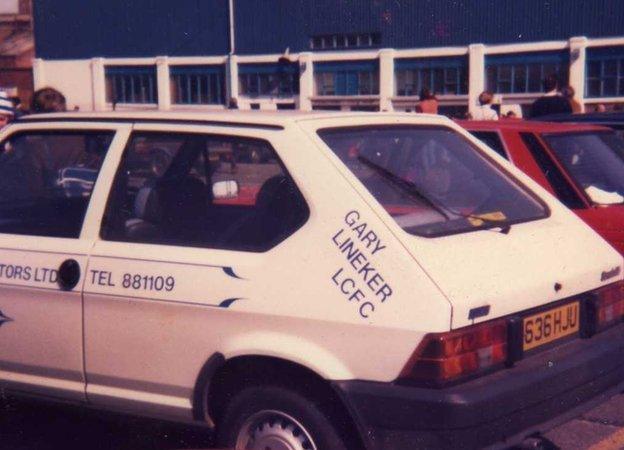
Future England captain Gary Lineker, who scored for Leicester City against Shrewsbury aged 21, had his own sponsored Fiat Strada car
Young, now 59, said: "(At 2-2) I landed on my head... I remember coming to in the physio's room... The first thing I said was, 'Why have I got a green jersey on?'
"I went back up front for a few minutes to clear my head, then I went back in goal. These days I wouldn't have come back on the pitch. I'd be in hospital having scans."
The two stand-in keepers both kept clean sheets. Young said: "I keep telling Wally, 'You should've come off earlier!'"

The rest of the kit...

Mark Lawrenson is seen here in Liverpool's kit at Newcastle in August 1985
In the 1980s, when Liverpool were the team to beat, shorts really were short.
"They were dead small… no idea how that came about," said fan Graham Agg, 51, who saw his first Liverpool game in 1971.
"Now they're down to the knees. (It's) almost back to the 20s and 30s. I'd have probably thought the shorter the shorts, the better the movement, but they've gone longer."
And what happened to black boots? Now, pink and orange ones dazzle fans.
"I remember in the 70s, one player in white boots was Alan Ball when he was at Everton," said Mr Agg.
"It was so unusual. Now it's unusual to see a player with black boots."

Plastic pitches
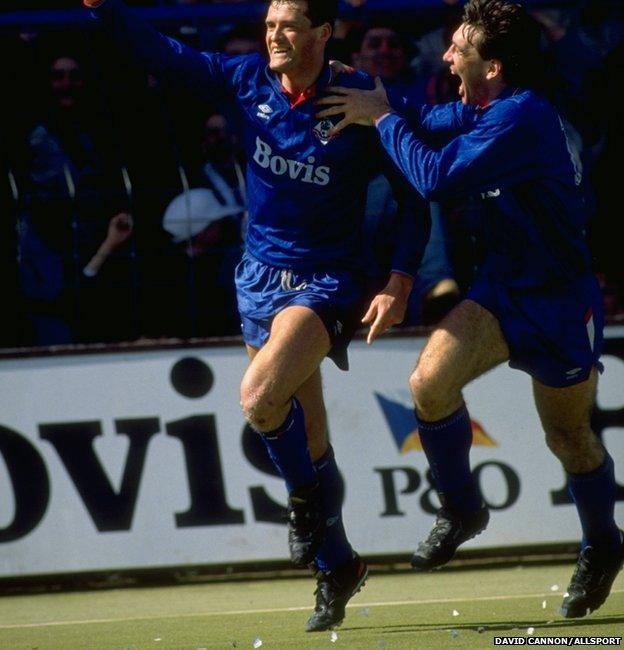
Frankie Bunn (left) and Rick Holden of Oldham celebrate against Leeds in an old Division Two game at Boundary Park in April 1990
In the 1980s Oldham, QPR, Luton and Preston all had artificial pitches.
QPR were the first to get rid of theirs, in 1988; Preston were the last, in 1994, and a year later the pitches were banned from English professional football.
In 1990 Oldham reached the Littlewoods Cup final and FA Cup semi-final.
In 1991, during their fifth season on an artificial surface, they were crowned Division Two champions.
So did playing on plastic give them an advantage?
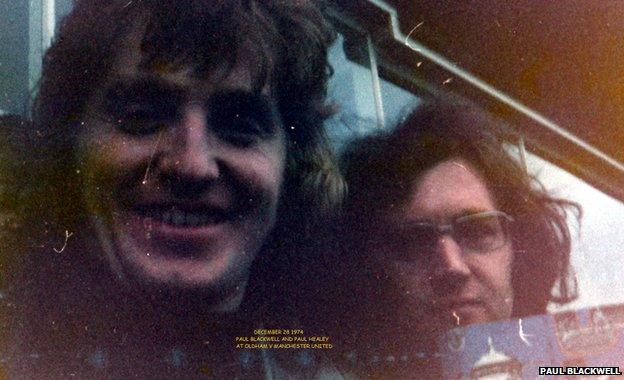
Paul Blackwell and his friend Paul Healey, holding the match programme, went to Oldham's game with Manchester United in December 1974
Paul Blackwell, who first watched them in 1954, aged seven, stressed: "You don't win the (Division Two) championship playing only at home.
"The football was terrific; very attacking, fast flowing. (Manager) Joe Royle cultivated an attacking style.
"(But) was it just coincidence (Oldham) had the best team, certainly since World War Two, at the same time as the pitch? It's an open question."
Mr Blackwell, 68, said there were negatives to the surface. When Oldham were "forced to rip it up", this left "a quagmire of a pitch... that cost us Premier League status".

So was it all better in the old days? John Williams, senior lecturer in sociology at the University of Leicester, said there were some unsavoury aspects of the game, including "the very overt (and barely challenged) routine racism among spectators" and "the terrible food and facilities" at grounds.
"On the pitch, the full-blown assaults (were) still allowed on opponents as a means of managing the game.
"Watching re-runs of Vinnie Jones' unpunished instant attack (on Steve) McMahon in the 1988 FA Cup final should offer at least a warning to those who think the game was always better in the past because it still allowed 'real' tackling."
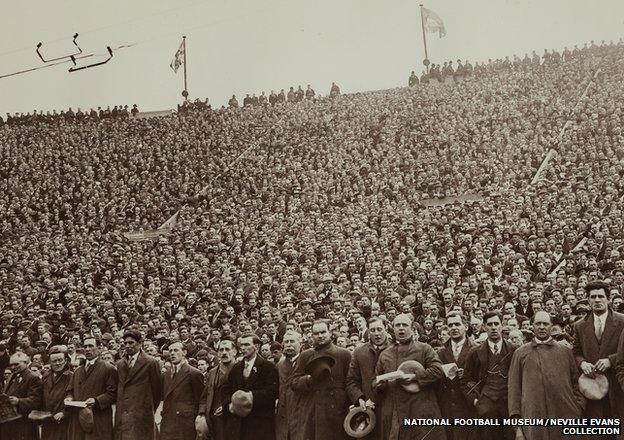
Fans gathered to watch the 1928 FA Cup final, in which Blackburn beat Huddersfield 3-1
Dave Woodhall, editor of Aston Villa fanzine Heroes & Villains, said: "It's incredible so many continued to watch football. You'd pay to watch a football match (and) you couldn't even see the whole pitch because of the fences; the layers of terracing. Oxford was a classic example.
"A lot of us who would like to get the old days back, what we really want is our youth back."
- Published25 October 2014
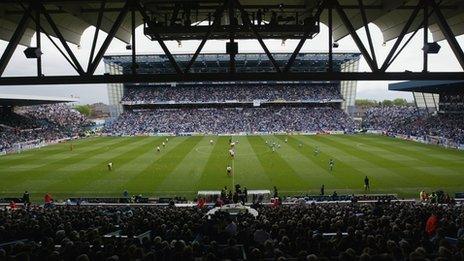
- Published21 October 2014
